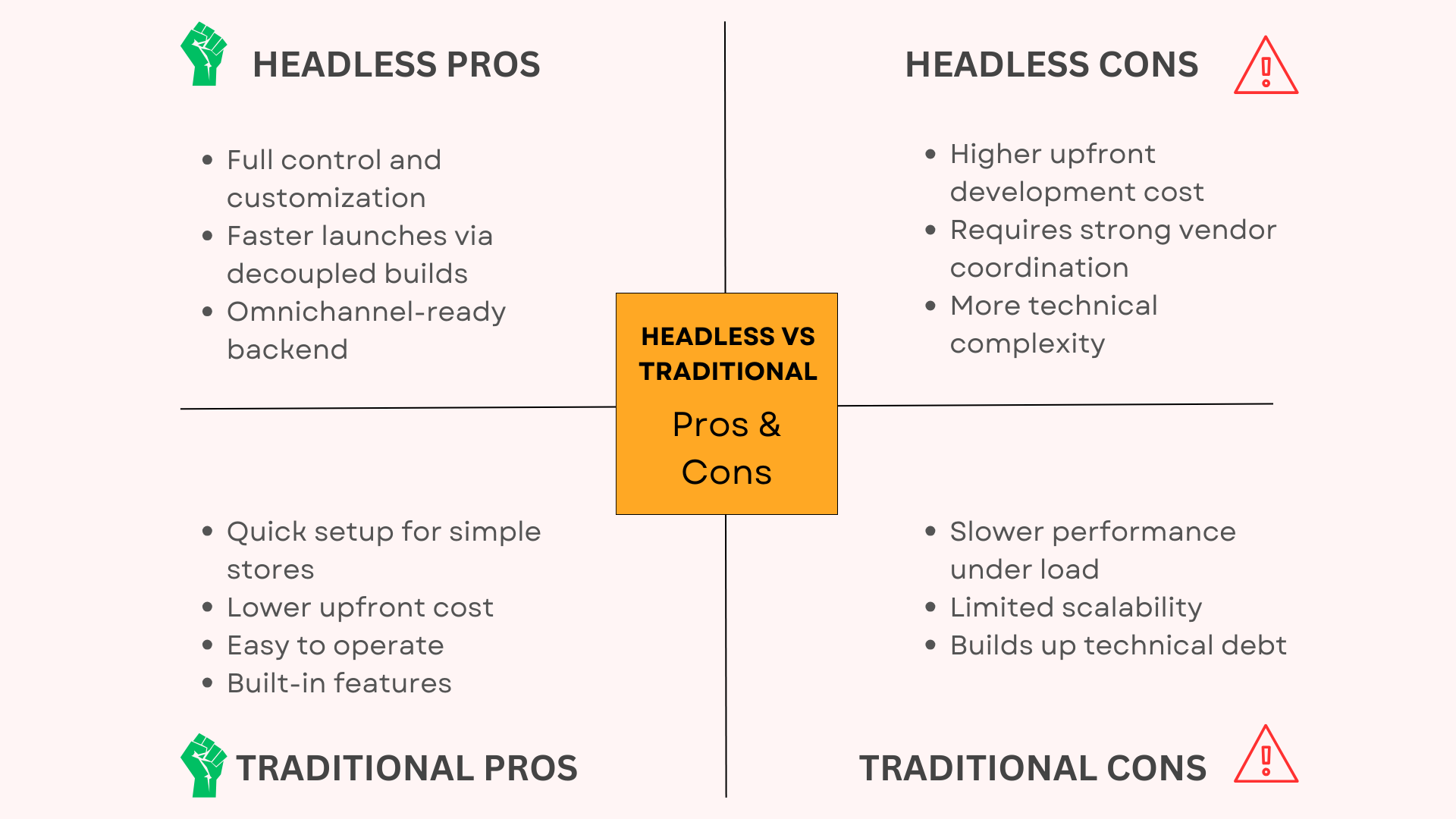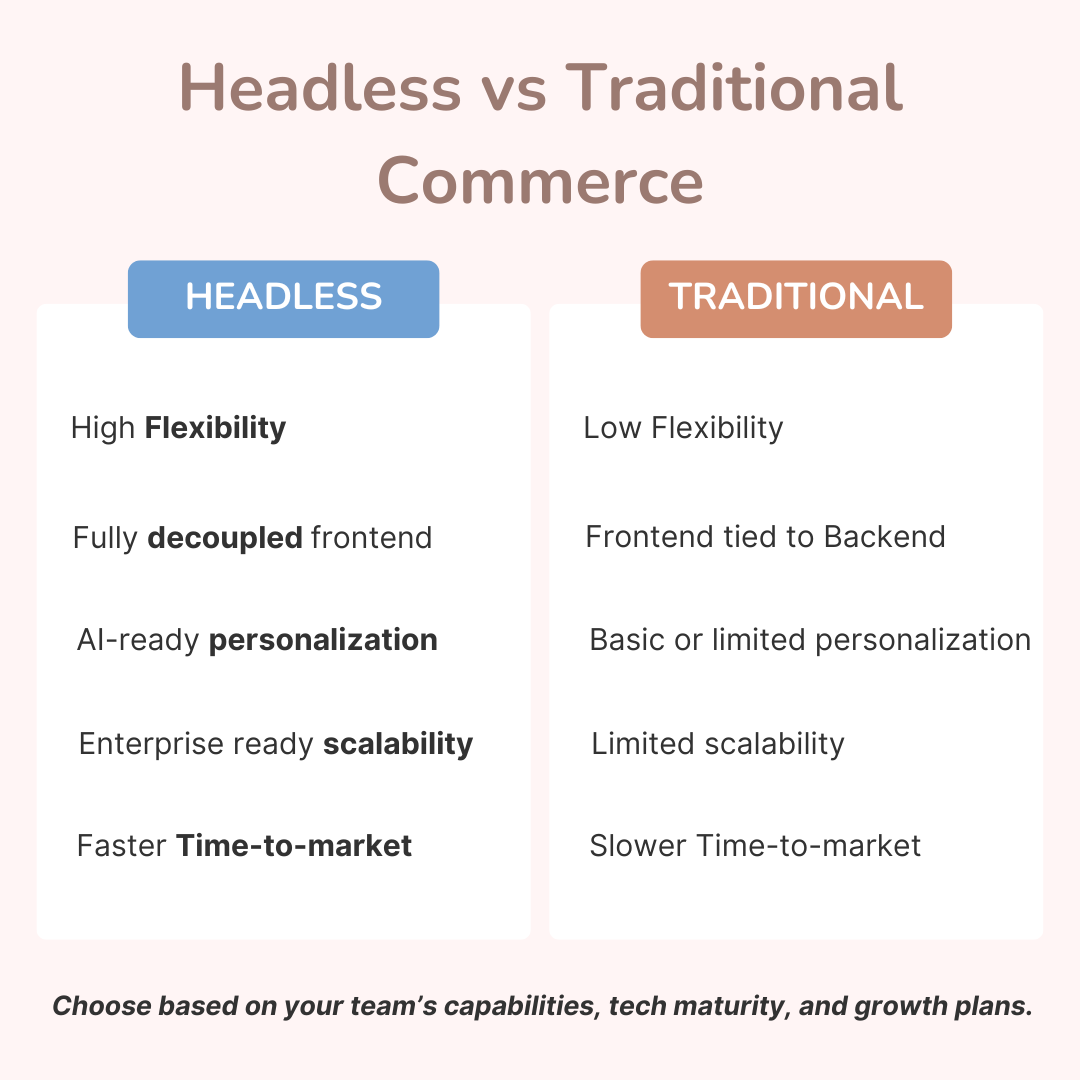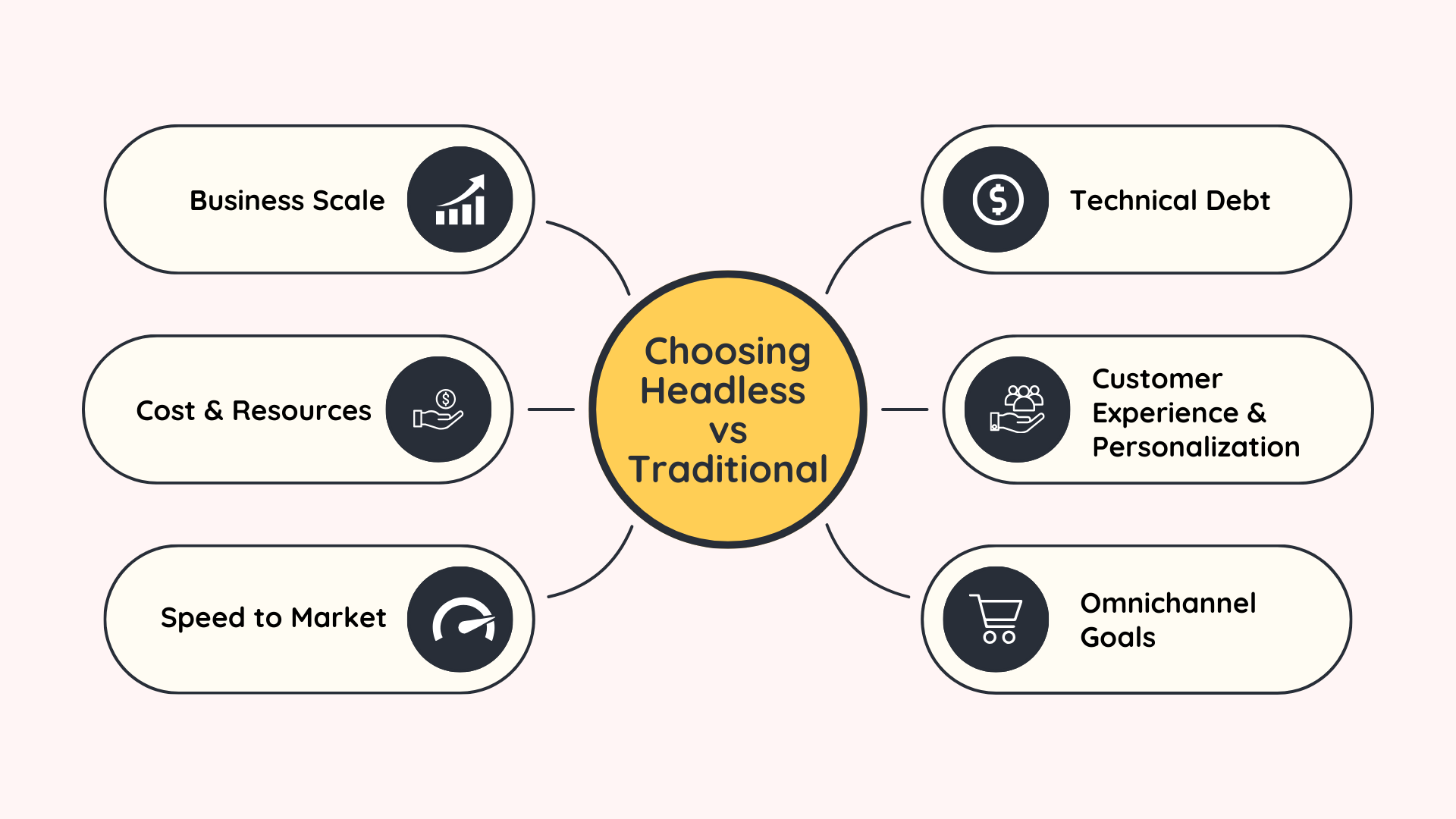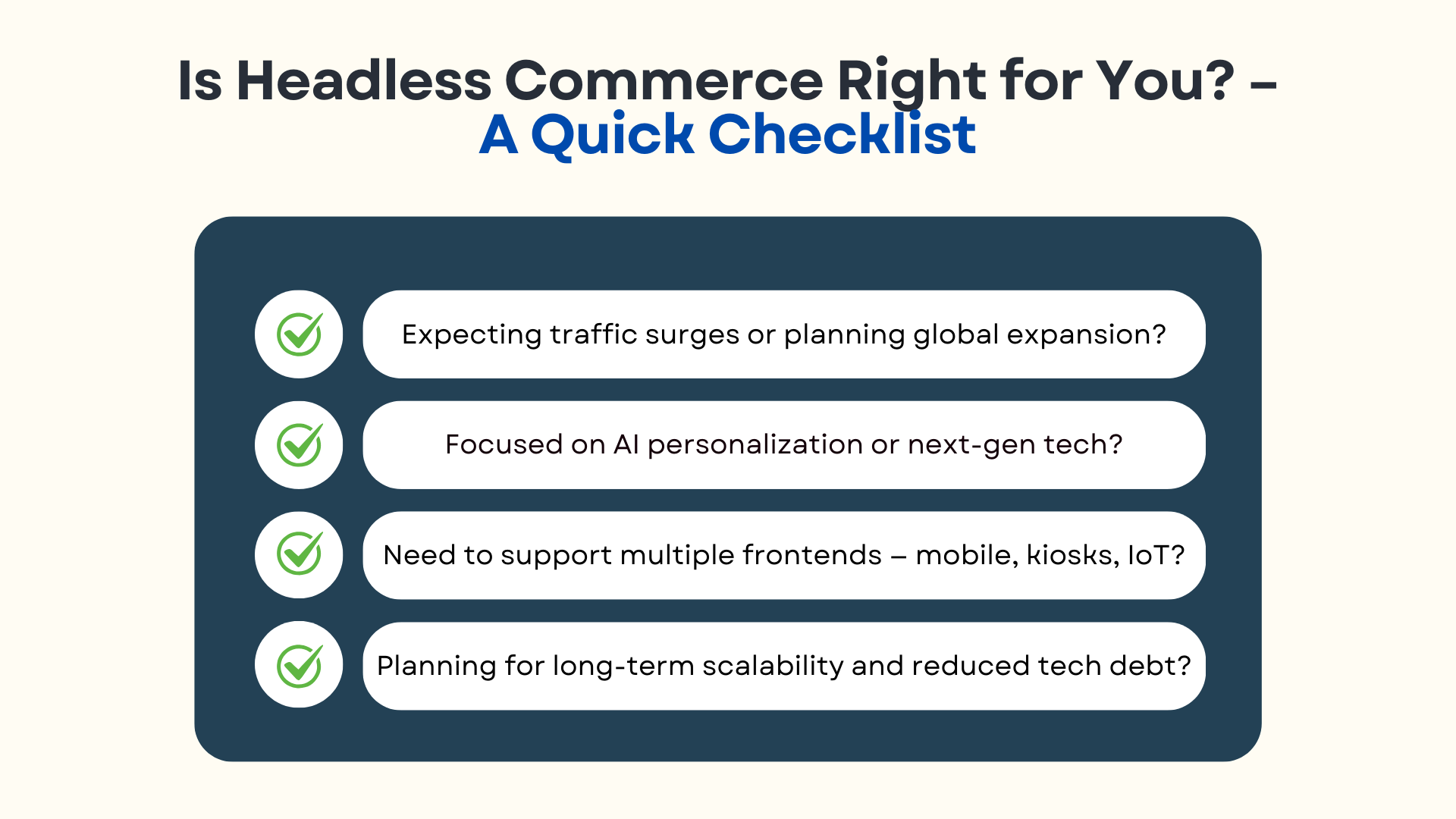Boosting Customer Retention with AI Powered Personalization


Businesses, when evaluating their architecture, often come to a point of comparison between a traditional architecture against a more complex headless approach. But the thing is, they have heard the word “headless commerce”, but many leaders don’t quite grasp what these words truly entail, or more importantly, how they’ll impact their company’s future. But the question arises, is headless just another passing trend? Or is it a fundamental shift in how modern commerce platforms should be built?
According to a Shopify report, the global e-commerce market is projected to reach 6.56 trillion USD in 2025 and will reach 8 trillion USD by 2027. In fact, McKinsey recently reported that modern consumers will tolerate less friction and expect faster and more personalized experiences; a shift that will differentiate companies almost overnight. If tomorrow’s leaders are to meet these rising expectations, their platforms must be engineered, not configured.
In this article, we will understand the differences between headless vs traditional commerce in simple terms, with not only their definitions, but also each of their pros and cons, the business impact, and choosing what’s right for your business.
The fundamental question between both isn’t technical; it’s philosophical. The debate between headless and traditional commerce is about architectural philosophy. Let’s understand the two architectures:
Traditional commerce platforms bundle front-end and back-end into a single monolithic code base. While this seems simple, the layers are locked together so tightly that changing the frontend can impact the backend or even the entire code structure. This architecture, often built on traditional databases including MySQL, PostgreSQL, lacks the responsiveness demanded by today’s real-time variants and omnichannel journeys.
Over the years, rigid coupling has been a bottleneck, accumulating technical debt. The same three-tier architecture that once seemed robust becomes, over time, the very ballast that hinders product teams from moving quickly and safely forward.
In contrast, headless commerce separates the front-end from the back-end business logic by integrating APIs. API gateways mediate between multi-client presentation layers and back-end logic housed in a single commercial engine. It’s an API-first architecture that separates the front-end presentation layer (“head” or user interfaces) from the core of backend business logic.
This uncoupled architecture becomes a constellation of lightweight, interconnected components, giving product teams the flexibility and freedom to assemble the optimal user experience, whether inside a custom mobile client, a responsive web journal, or a holographic AR shopping experience, while drawing from that same unified, API-accessed back-end.
Now that we have set the stage and explored the core difference between the two, let’s dive into the pros and cons of each commerce and understand the fundamental differences between the two.

When comparing headless vs traditional commerce, headless becomes a strategic future investment, whereas traditional is often a short-term solution with fewer scalability options for the future. Here’s a side-by-side comparison of headless and traditional commerce:

| Features | Traditional Commerce | Headless Commerce |
| Architecture | Monolithic or tightly coupled architecture | Microservices-based or decoupled, or API-first |
| Development Speed | Slower development speed, as any changes to the frontend affect the backend or vice versa | Faster development speed as the frontend is separate from the backend |
| Time to Market | Longer for new features or channels | Shorter enables rapid iteration and A/B testing |
| Scalability | It can do vertical scaling and is complex to scale | It can do horizontal scaling, meaning adding more microservices |
| Initial Costs | Lower initial upfront costs | Higher upfront costs due to customization |
| Personalization | Limited personalizations may lead to increased costs | Unlimited personalization with more tailored experiences |
Choosing between headless and traditional commerce depends on every business’s goals, needs, resources, long-term visions, and more, and this comes only after having a detailed business analysis.

Traditional commerce provides better value in the case of small businesses. It requires fewer implementation costs and provides quick deployment to market, but with all these features, one drawback is that it is less scalable compared to headless commerce.
A headless architecture is strategically necessary for a major organization with complicated omnichannel needs and global operations. For instance, we helped online furniture leaders expand from the US to Europe, localizing their experience.
A headless migration is a monumental task. However, with RBM’s staff augmentation and certified project management prowess, we can bring in the technical power to make the transition seamless. This is a key transformation for any company battling a legacy system; it liberates them from the chains of technical debt.
If the business is not making decisions quickly, they are far behind its competitors. With the speed of growing digital commerce, where innovation is at its peak, new ideas are launching, speed and agility are essential, and can’t be compromised.
A traditional system works well when your goal is to sell a few products with a smooth checkout flow in your business. But if you value customers’ needs, want to give personalization to your customer, an interactive experience, or AI-driven personalization, a headless approach is the only way to achieve it.
Here are a few common issues to watch out for, along with tips that can help in the smooth migration process:
RBM’s approach to addressing the complexity is through expertise, which includes their offshore development teams, flexible engagement models, and transparent pricing. Here’s how the approach looks:

Headless commerce is the future of e-commerce or digital commerce, and the decision to choose will be a strategic investment for your business. Consider the checklist below to see whether you need a headless commerce architecture:
Now, if your answer to most of the above questions is YES, headless commerce is the right choice for you.
After understanding the difference between headless vs traditional commerce, the choice of which approach to choose depends on your business needs. But note that headless commerce is not just about following the trends; it’s a strategic future investment. The headless commerce market is booming, expected to hit 13.2 billion USD by 2035. This isn’t just a trend; it’s the future of e-commerce.
At RBM Software, we’ve helped top brands modernize their old systems and transition to flexible, composable architectures that are built to scale with greater flexibility. If you’re ready to move on from your legacy setup, let’s talk.
Book a free consultation with our team. We’ll dive deep into your current platform and help you map out a clear, scalable plan for your business.